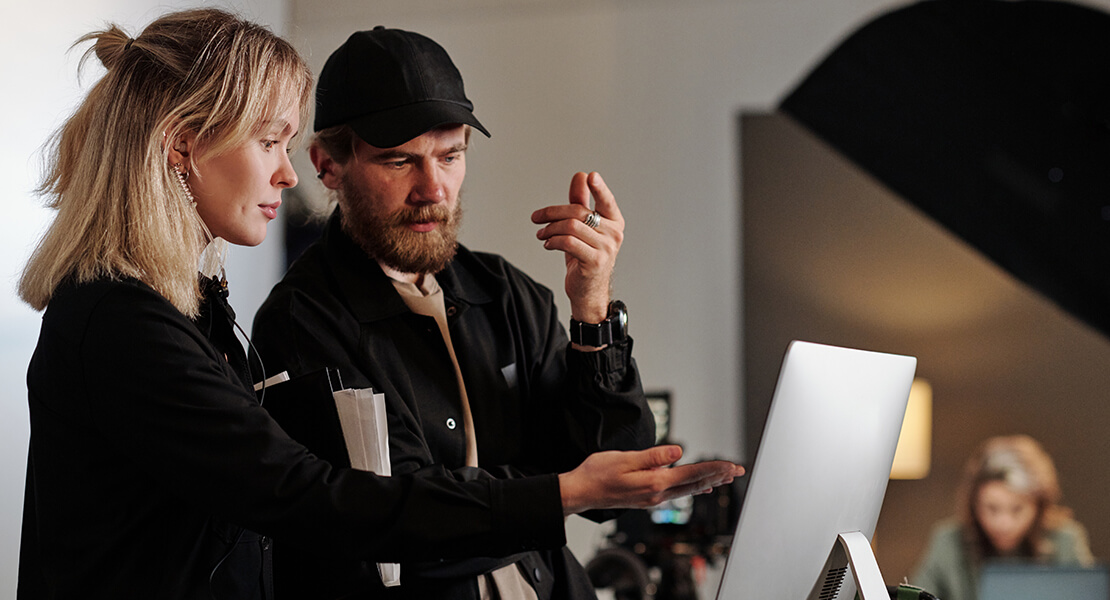
When it comes to video production, we often focus on visuals, storytelling, and technical flair. But there’s one area that doesn’t always get the attention it deserves: accessibility. Making your video content accessible isn’t just a nice-to-have—it’s a must if you want to reach a truly diverse audience. Whether you’re producing content for marketing, training, or education, creating videos that everyone can engage with should be a core part of your strategy.
Let’s explore what accessible video really means, why it matters, and how you can make your content inclusive from the start.
Why Accessibility Should Be a Priority
First, let’s talk about why this matters. According to the World Health Organization, over a billion people worldwide live with some form of disability. That’s roughly 15% of the global population—millions of potential viewers who may be excluded if your content isn’t designed with them in mind.
Accessibility is also about more than disability. It covers language barriers, learning differences, temporary impairments, and even situational limitations—like watching without sound on a busy train. By making your videos accessible, you’re not just being considerate—you’re being smart. It improves user experience for everyone, boosts your SEO, and can even be a legal requirement in some regions.
Think of accessibility as an investment in inclusivity. It expands your reach, builds goodwill, and demonstrates your brand’s commitment to equity. Accessible content is also more likely to be shared, remembered, and acted upon. For example, people with dyslexia may find video easier to follow than dense written material, and non-native speakers may benefit from clear visual cues and simplified language.
There’s also a reputational aspect. Brands that take inclusion seriously are viewed more favourably—both by consumers and by search engines. Companies ignoring accessibility risk being left behind, especially as digital content becomes more regulated worldwide. The UK’s Equality Act 2010, for instance, requires reasonable adjustments to digital services, including websites and videos.
Ultimately, accessibility shouldn’t be an afterthought or a compliance box to tick. It should be embedded into every stage of your production process—from planning and scripting to editing and distribution. By embracing it, you’re not only making your content more effective—you’re showing your audience that you care enough to include everyone.
Captions and Subtitles: More Than Just Words on Screen

Captions are often the first thing people think of when it comes to accessibility—and with good reason. They’re essential for deaf and hard-of-hearing viewers, but they also help anyone watching without sound, such as commuters or those in noisy environments.
There are two main types to consider:
- Closed captions, which can be turned on or off by the viewer.
- Open captions, which are permanently embedded into the video.
Make sure your captions are accurate, properly timed, and include relevant sound effects or speaker identifications where necessary. And remember, auto-generated captions can be a useful starting point, but they nearly always require manual editing.
Captions do more than just transcribe dialogue—they can add context, improve understanding, and increase engagement. They’re also a valuable tool for viewers who process information better visually or have difficulty following accents or fast speech. Well-crafted captions can even enhance comprehension for children and adults learning English.
From a technical perspective, captions improve your SEO by making your video content indexable by search engines. This means your video can appear in more search results, driving organic traffic to your site. Additionally, many social media platforms auto-play videos without sound, so captions play a vital role in grabbing attention and encouraging users to stick around.
When writing captions, keep the language simple and concise. Avoid overloading the screen with text, and make sure the captions don’t clash with visuals or branding. Position them clearly, preferably at the bottom centre, and test them on both mobile and desktop devices to ensure readability.
In short, captions are more than a courtesy—they’re a cornerstone of effective, inclusive video content. When done right, they elevate your video’s impact and ensure your message reaches a broader, more diverse audience.
Audio Descriptions: Letting the Visuals Speak to Everyone
Audio descriptions provide narration that describes important visual elements of a video—like actions, facial expressions, or scene changes. They’re essential for blind or visually impaired viewers, offering context that the audio alone may not convey.
Creating effective audio descriptions means balancing detail with timing. You don’t want to overload the viewer, but you do want to ensure that nothing essential is missed. They can be added as a separate audio track, allowing users to choose whether to activate them.
Beyond simply describing what’s on screen, audio descriptions should be crafted to match the tone and pace of the video. If the content is fast-paced and energetic, the narration should reflect that rhythm without sounding rushed. If it’s serious or emotional, the delivery should be sensitive and considered. The goal is to complement the original video, not to distract from it.
This accessibility feature is particularly important in films, documentaries, and explainer videos where non-verbal cues play a big role. For example, in a corporate training video, a nod of approval from a manager or a disapproving facial expression can convey a great deal. Without audio description, these moments are completely lost to blind viewers.
Producing audio descriptions might seem like an extra step, but it can be seamlessly integrated into the post-production workflow. And thanks to improvements in technology, more video platforms now support multiple audio tracks, making it easier than ever to deliver a richer, more inclusive experience.
Ultimately, audio descriptions offer a bridge between the visual and auditory. When you include them, you ensure your story reaches everyone, regardless of how they experience the world.
Use of Clear and Inclusive Language
The language you use in your script and voiceover also plays a big role in accessibility. Avoid jargon, slang, and overly complex sentences. Speak clearly and at a measured pace.
If you’re creating training or educational videos, consider pairing spoken instructions with on-screen visuals or text to support different learning styles. Think about neurodivergent viewers or those with cognitive impairments—clarity and simplicity go a long way.
Using plain English is one of the most powerful ways to improve comprehension. Short, direct sentences are easier for everyone to follow, especially for people who speak English as a second language or who struggle with processing spoken information quickly. Avoid idioms or culturally specific references that may not make sense to a global audience.
Tone matters too. A friendly, conversational tone tends to be more engaging and easier to process than something overly formal or robotic. If your video features voiceover, choose narrators with clear enunciation and neutral accents, unless a specific regional dialect is important for authenticity or relatability.
Inclusive language also means being mindful of how people are described. Avoid outdated or offensive terms, and default to person-first language where appropriate—like saying “person with a disability” rather than “disabled person,” unless otherwise preferred by the group being referenced.
Finally, think about the emotional accessibility of your script. Is it welcoming? Is it respectful? Is it encouraging? Language sets the tone for your entire video, and small tweaks can make a big difference in how inclusive your message feels. Whether your audience is diverse in age, background, or ability, clear and inclusive language helps ensure that no one is left behind.
Colour Contrast and Visual Clarity

For viewers with visual impairments or colour blindness, poor colour contrast can make on-screen text and graphics hard to see. Always check that your text stands out against the background and avoid using colour alone to convey meaning.
There are plenty of tools available online—like contrast checkers—that can help you make sure your content is visually accessible. Stick to high-contrast combinations (such as dark text on a light background), and test your videos on various devices and screen sizes.
In practice, this means avoiding light grey text on white or red text on green—combinations that are particularly challenging for people with different types of colour blindness. Also, consider viewers watching in brightly lit environments where screen glare can reduce contrast. Use bold fonts and increase font size where possible to aid readability, especially on mobile.
Animations and transitions should also maintain clarity. Overly complex visuals, rapid flashes, or layered graphics can not only be visually confusing but may also pose a risk for viewers with conditions like photosensitive epilepsy. Smooth, clean transitions and a tidy layout are not just stylistic choices—they’re part of an inclusive approach.
And remember, colour should support meaning, not be the sole conveyor of it. If you’re using colour-coded charts or visual cues, back them up with icons, text labels, or patterns so no viewer is left guessing. Prioritising visual clarity makes your content more professional and much easier for everyone to follow.
Keyboard Navigation and Screen Reader Compatibility
If your video is hosted on a platform like your own website, the player itself needs to be accessible. That means users should be able to:
- Navigate the player using only a keyboard.
- Use screen readers to access controls and descriptions.
Make sure buttons are labelled clearly and that your video player supports keyboard shortcuts and closed caption functionality.
Keyboard navigation is vital for users who cannot use a mouse due to mobility issues, injuries, or preference. They should be able to use the “Tab” key to move between controls and press “Enter” or “Space” to activate features such as play, pause, or volume. Poorly designed players can trap users in a control loop or skip essential buttons entirely—so thorough testing is essential.
Screen readers, on the other hand, interpret on-screen content and read it aloud to the user. For this to work properly, every interactive element must be correctly tagged with descriptive labels. Instead of simply “Button 1,” it should say “Play Video Button” or “Toggle Captions.”
Many off-the-shelf video players claim accessibility compliance, but not all are created equal. Choose a player that adheres to WCAG (Web Content Accessibility Guidelines) and regularly update it to avoid security or compatibility issues. And don’t forget your surrounding page content—ensure video titles, descriptions, and transcripts are equally accessible.
Ultimately, accessibility is not just about the video file itself, but about how viewers interact with it. Make that interaction seamless and inclusive, and you’ll dramatically expand your video’s impact.
Inclusive Casting and Representation
Accessibility isn’t just about features—it’s also about inclusion. Who’s in your video? Are you showing people of different backgrounds, abilities, and ages?
Representation matters. Seeing someone who looks or speaks like you builds a sense of connection and trust. It tells the viewer, “This content is for you.” Whether it’s a customer testimonial or an animated explainer, consider diversity in every stage of production.
This starts in pre-production. Think about your casting choices—not just in terms of talent, but also the behind-the-scenes crew. Aim to include people from underrepresented groups in your writing, directing, and production teams. This enriches perspectives and avoids tone-deaf decisions that can alienate viewers.
Be intentional. It’s not about ticking boxes or forcing diversity—it’s about reflecting the world we live in. Include people with visible and invisible disabilities. Feature diverse body types, genders, ages, and cultural backgrounds. And don’t limit diverse representation to stories about diversity. Everyone should be able to feature in a product video, a training clip, or an advert for financial services—just like anyone else.
Even in animation, where character design is often stylised, representation still counts. Consider diverse skin tones, accents, cultural attire, and assistive devices such as hearing aids or wheelchairs.
Ultimately, inclusive casting sends a powerful message: your content is made with everyone in mind. And when people feel seen, they’re more likely to engage, share, and support what you’re creating.
Translations and Multilingual Subtitles
If you’re targeting an international or multilingual audience, subtitles in different languages can dramatically expand your reach. But don’t rely on auto-translate functions—they often miss the nuance and tone of your original message.
Professional translation ensures that your content is not only understandable but culturally relevant. This helps your message land with more impact and demonstrates respect for your global viewers.
When done well, multilingual subtitles show that your brand values inclusion across borders. A viewer in Paris, São Paulo, or Mumbai should be able to understand your content just as clearly as someone in London. This is especially important for educational or instructional videos, where clarity can directly affect learning outcomes.
But it’s not just about words—it’s about localisation. A good translator won’t just convert the language, but will adapt phrases, examples, and even humour to suit the cultural context of the target audience. This small step can dramatically improve viewer connection and comprehension.
Consider going a step further by offering full dubbed versions or region-specific voiceovers. Subtitles are a great start, but some audiences—especially older viewers or those with lower literacy—may engage more with spoken translation.
From a technical perspective, make sure your video platform supports subtitle tracks in multiple languages and allows easy switching between them. Clear labelling and user-friendly controls are key.
Making your videos multilingual doesn’t just open the door to wider markets—it builds bridges across them.
Platform Considerations: Where You Publish Matters
Different platforms offer different levels of accessibility support. YouTube, for instance, allows users to upload caption files and add multiple subtitle tracks. LinkedIn and Instagram, on the other hand, have limitations that require more creative solutions—like burning in subtitles or including descriptive copy in captions.
Always test your content on the platforms your audience uses most and make sure you’re aware of their accessibility tools and limitations.
For example, Facebook offers auto-captioning tools but requires manual review for accuracy. TikTok supports captions but not alternate audio tracks. Vimeo provides support for closed captions and transcripts, but it may not be the preferred platform for short-form mobile content. Each channel comes with its own strengths, quirks, and accessibility challenges.
You should also consider how your audience will consume the video—are they watching on mobile, desktop, or smart TVs? Does the platform autoplay videos with sound off, as Instagram does? These factors influence how you present your captions, visual cues, and overall design.
Don’t forget to include alt text and accessible descriptions where possible when posting video thumbnails or linking to video content. These details can make a big difference for screen reader users browsing your content. By taking the time to understand the limitations and features of each publishing platform, you ensure your accessibility efforts are consistent—and effective—no matter where your video appears.
Embedding Accessibility into Your Workflow

One of the most common mistakes is treating accessibility as an afterthought. Instead, make it part of your process from day one. This might include:
- Writing scripts with audio descriptions in mind.
- Planning time for captioning and translations.
- Budgeting for accessible player platforms or tools.
It’s much easier—and more cost-effective—to build accessibility into your content as you go than to retrofit it later.
Start by including accessibility checkpoints in your project timeline. From the concept stage, identify key opportunities to build inclusivity—such as choosing diverse on-screen talent or deciding whether animations will need descriptive audio tracks. When writing scripts, flag important visual moments that may need describing for those who can’t see the screen.
During production, think about contrast, clear visuals, and minimal visual clutter. If filming interviews or testimonials, position speakers with good lighting and minimise background distractions. Record audio clearly and reduce background noise where possible to make voiceovers and captions more accurate.
When budgeting, factor in professional captioning services, translation, and additional recording time for audio descriptions. Investing here pays off in a more polished, compliant, and inclusive final product.
Finally, create internal documentation or a checklist so your team is aligned on accessibility goals. Making accessibility a core part of your production culture encourages consistency—and shows your audience that inclusion is more than a box you’re ticking. It’s part of how you work.
Final Words: Accessibility Is Everyone’s Responsibility
Accessibility in video production isn’t just about compliance or ticking off a list of features—it’s about putting people first. It’s about recognising that your audience is diverse, with different needs, preferences, and ways of engaging with content. By making your videos more accessible, you’re not just reaching more people—you’re respecting them.
The good news is that accessibility doesn’t require a massive overhaul. Many of the steps we’ve discussed—like adding captions, choosing high-contrast visuals, or writing clear scripts—can be integrated smoothly into your existing workflow. And once they become part of your process, they’ll feel as natural as hitting “record.”
Ultimately, accessible content is better content. It’s clearer, more thoughtful, and more widely appreciated. Whether you’re creating a training module, a brand story, or an animated explainer, designing with accessibility in mind ensures your message lands with impact—for everyone.
So the next time you plan a video, ask yourself: who might I be leaving out? And more importantly—what can I do to bring them in? The answers to those questions won’t just improve your videos. They’ll elevate your entire brand.
If you’d like help with your video production, you can get in touch with us at Spiel for a free strategy consultation. Let inclusion lead the way.

